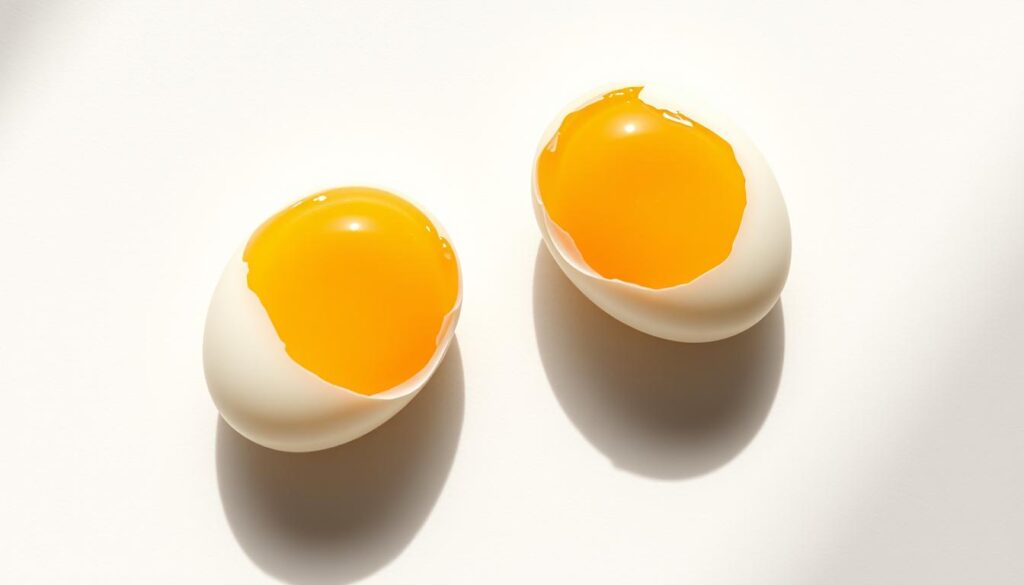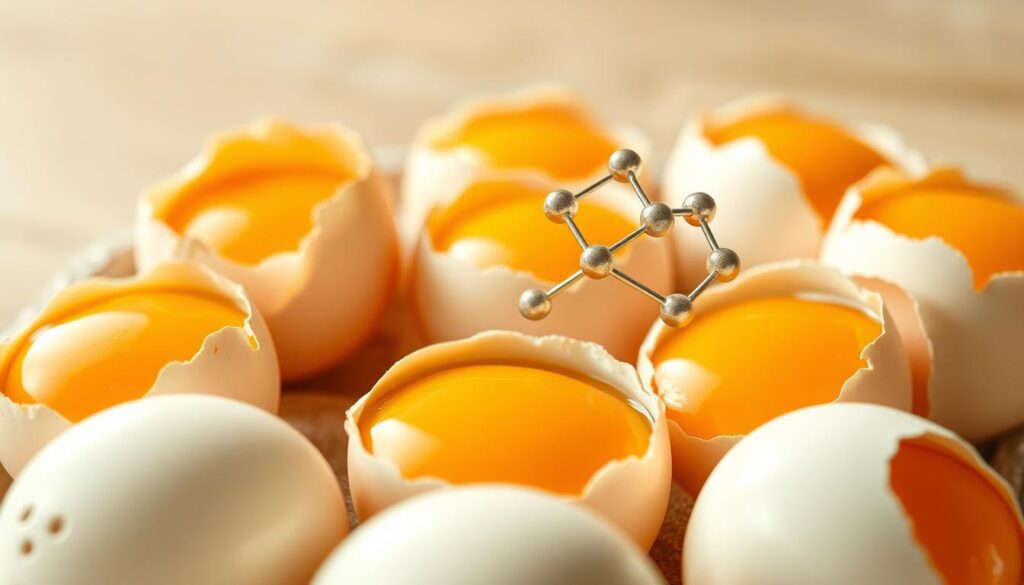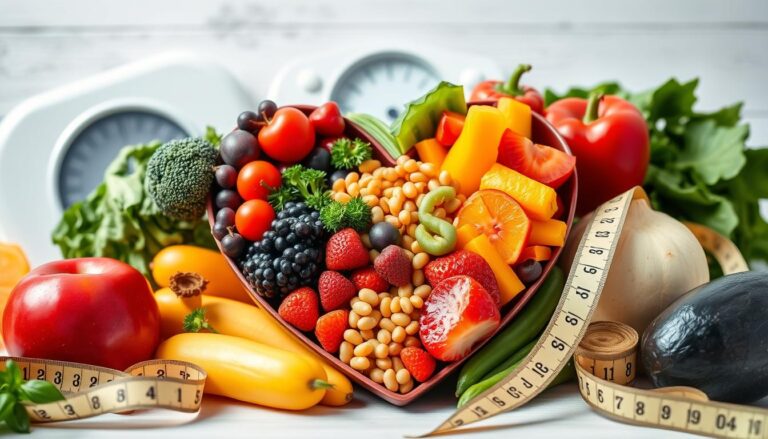Every morning the sizzling sound of eggs in a pan promises something. Two eggs in a pan mean an easy healthy filling and nutritious meal.
If you want to increase your protein intake effortlessly eggs are a great place to start.Read more
A single large egg has about 6 g of high-quality protein, ~78 calories, and ~5 g fat with almost no carbs. Two large eggs give you roughly 12 g of eggs protein and about 156 calories before adding butter or oil. This is perfect fuel for a busy morning, post-workout or a quick dinner.
Eggs are more than just protein. They also have vitamins A B2 B5 B12 folate selenium and phosphorus plus smaller amounts of vitamin D vitamin E vitamin B6 calcium and zinc. The yolk is packed with choline lutein and zeaxanthin which are good for your brain and eyes. For extra nutrition look for omega-3 enriched or pastured eggs.
If you’re aiming for high protein eggs are a great choice. The protein in 2 eggs can anchor a meal keep hunger away and aid in recovery. It’s a small habit with big benefits, easy to do every day without breaking the bank. Eggs are a powerhouse among everyday proteinsources.
Key Takeaways
- Two large eggs provide about 12 g of high-quality protein with roughly 156 calories before cooking fats.
- Eggs supply vitamins A, B2, B5, B12 folate selenium and phosphorus plus small amounts of vitamin D and E.
- Yolks deliver choline lutein and zeaxanthin that support brain function and eye health.
- The protein in 2 eggs helps stabilize appetite and supports a high protein eating pattern.
- Omega-3 enriched or pastured eggs can add healthy fats and more vitamins for smarter protein sources.
- eggs protein is versatile easy to prep for breakfast, lunch, or a fast balanced dinner.
What Makes Eggs a High Quality Protein Source for a High Protein Diet
Eggs are packed with nutrients and steady energy, making them great for a high protein diet. One large egg has about 6 grams of complete egg protein and very few carbs. This balance is perfect for active people who want to eat #proteinrich without too many calories.
Cooked simply poached or hard-boiled eggs offer efficient protein per bite. They are great for anyone watching their macros or looking for highes tprotein foods that are easy on the wallet. They provide quick energy for busy mornings and after workouts.
#proteinineggs and complete amino acid profile
protein is ineggs has all nine essential amino acids in the right amounts. Your body can use them right away. This is why eggs are a top choice for a #proteinrichdiet.
Why egg protein is considered one of the best protein sources
egg protein is very digestible and efficient, making it one of the bes tprotein options. Each egg offers reliable protein with a familiar taste and easy preparation. This makes eggs a great fit for a high protein diet.
How egg protein supports muscle, bones, and weight management
Eggs have amino acids that help repair muscles after exercise and support strong bones. They also keep you full which can help with snacking and weight control. When cooked with little fat eggs offer a lot of protein for their calories in a proteinrichdiet.
Nutrition Snapshot Calories Protein Fat and Key Vitamins in Eggs
Eggs are packed with nutrients that meet many dietary needs. They provide steady protein intake and balanced breakfasts. For those making a protein food list eggs are a great choice for their value and versatility.
Per large egg ~78 calories ~6 g protein ~5 g fat trace carbs
A large egg has about 78 calories and ~6 grams of quality protein. It also has ~5 grams of fat and almost no carbs. This makes them perfect for low carb and high #protein diets.
Vitamins and minerals A B2 B5 B12 selenium phosphorus folate
Large eggs are not just for eggs protein. They also have vitamins A B2 B5 B12 folate selenium and phosphorus. This mix boosts any protein food list while keeping portions small.
egg white protein vs whole egg nutrients
egg white protein has about 3 grams of protein and 16 calories with almost no fat. The yolk has 3 grams of protein more calories and fat and most vitamins and choline. Whole eggs have lutein and zeaxanthin which whites lack.
| Component | Whole Egg Large | Egg White Large cooked | Egg Yolk Large cooked |
|---|---|---|---|
| Calories | ~78 kcal | ~16 kcal | ~59 kcal |
| Protein | ~6 g | ~3 g | ~3 g |
| Total Fat | ~5 g | ~0 g | ~6 g |
| Carbohydrate | ~1 g (trace) | ~0 g | ~0 g |
| Key Vitamins | A B2 B5 B12 folate D, E | Minimal | A, D E B12 folate |
| Minerals | Selenium phosphorus zinc | Trace | Selenium, phosphorus |
| Notable Compounds | Choline, lutein, zeaxanthin | — | Choline lutein zeaxanthin |
| Best Use | Broader nutrition and protein intake | Lean #protein and fewer calories | Micronutrients to round out protein food list |
| SEO Relevance | how much protein how much proteinin egg eggs protein | how much protein eggs protein | how much protein in egg protein foodlist |
protein in 2 eggs
Protein in 2 eggs is about 12 grams. This is because each large egg has 6 grams of protein. So, two eggs make a great #highprotein breakfast or snack.
The yolks add B2 B5 B12 selenium and phosphorus. They also have about 294 mg of choline for brain and cell health. This answers questions like how much protein in eggs and how much protein is in eggs with clear numbers.
Calories and fat vary with cooking methods. Two hard-boiled eggs have about 156 kcal and 10 g fat. A two egg scramble has 189 kcal and 14 g fat. Two fried eggs have 173 kcal and similar fat but the same protein.
For quick meal math remember the rule of two: 12 g protein steady amino acids, and helpful fat-soluble nutrients from the yolk. This keeps protein in 2 eggs consistent across breakfasts, bowls, and sandwiches without guesswork.
Scrambled fried or boiled, the protein stays the same. Eggs are easy to track in a high protein routine. They are a compact source that fits into busy mornings with predictable macros and familiar flavor.
Egg Whites vs Whole Eggs Protein Calories, and Micronutrients
Egg parts are great for a high protein diet but they serve different roles. Egg whites are lean and simple. Egg yolks are rich and full of color. Knowing what’s in each helps plan a balanced easy protein meal and understand protein is in eggs.
| Part | Protein cooked | Calories | Fat | Key Micronutrients |
|---|---|---|---|---|
| Egg white | ~3 g | ~16 kcal | ~0 g | Potassium sodium riboflavin base of egg white protein |
| Yolk | ~3 g | ~59 kcal | ~6 g | Choline vitamins A, D, E, B12, folate selenium lutein zeaxanthin |
| Whole large egg | ~6 g | ~74–78 kcal | ~5 g | Complete amino acids phosphorus carotenoids full value protein is in eggs |
how much protein in egg whites compared to yolks
Whites and yolks each have about 3 grams of protein per large cooked portion. The difference is in calories and fat not amino acids. This is why egg whites are lighter and yolks are richer.
Trade offs fewer calories in egg whites, but yolks carry choline vitamins, lutein zeaxanthin
Whites have fewer calories and almost no fat. Yolks offer choline for cell health and carotenoids like lutein and zeaxanthin for vision. Together they make a balanced protein is in eggs for a high protein diet.
When to choose egg whites for a high protein low calorie meal
Choose whites for more protein per calorie like in a pre-workout omelet or a late-night snack. For balance add one whole egg to extra whites. This boosts egg white protein while keeping nutrients from the yolk. It’s perfect for a lean easy protein meal and keeps macros steady for training days.
Cooking Methods and Protein in Popular Two Egg Dishes
Cooking changes calories and fat more than protein. If you track how much protein in eggs for a high protein egg meal the method matters. Each option below keeps core #eggsprotein steady while adjusting energy and texture. This makes it an easy prote in meal to fit your day.
Tip Use nonstick pans or a light spray to curb added fat. Poaching or boiling keeps the nutrition tight without crowding the plate.
Scrambled with 2 eggs ~13 g protein ~189 kcal ~14 g fat
Creamy curds deliver steady #eggsprotein with a soft bite. For protein scrambled eggs stir over low heat and skip heavy cream. A pat of butter adds richness but also most of the fat.
Fried 2 eggs ~12 g protein ~173 kcal ~14 g fat
Sunny-side or over-easy keeps the yolk runny. The skillet fat sets texture and drives calories. Choose avocado oil or olive oil for a cleaner high protein egg meal.
Poached hard boiled per egg ~6 g protein ~74–78 kcal ~5 g fat
Poaching or boiling adds no extra oil while preserving eggs protein. Two eggs land near 12 g protein with lean calories ideal for salads, grain bowls or a quick easy protein meal.
Omelets made with 2 eggs protein ranges ~15–18 g depending on fillings
Fillings set the pace. Cheese pushes protein up while vegetables add volume and fiber. Ham or smoked turkey raises protein density for a compact, travel-friendly plate.
| Two Egg Dish | Protein g | Calories kcal | Fat g | Notes for high protein egg meal |
|---|---|---|---|---|
| Scrambled butter | ~13 | ~189 | ~14 | Low, slow heat; skip cream for lighter protein scrambled eggs |
| Fried 1 tsp oil | ~12 | ~173 | ~14 | Swap to olive oil blot excess for a lean easy protein meal |
| Poached 2 eggs | ~12 | ~148 | ~10 | No added fat best for bowls and toast with eggs protein |
| Hard boiled 2 eggs | ~12 | ~156 | ~10 | Meal prep friendly easy portion control |
| Omelet cheese 2 eggs | ~18 | ~273 | ~20 | Higher protein and fat pick lighter cheeses as needed |
| Omelet Western ham peppers onions | ~17 | ~237 | ~17 | Balanced option with savory add-ins |
| Omelet, Spanish-style vegetables | ~15 | ~319 | ~24 | Vegetable heavy olive oil raises calories |
| Eggs Benedict 2 eggs | ~34 | ~572 | ~35 | Hollandaise drives fat and sodium protein remains high |
To keep how much protein in eggs consistent, focus on added fats and sauces. Poached or hard boiled protects protein per egg while omelets can boost totals with lean fillings. This makes for a smart satisfying high protein egg meal.
Heart Health Cholesterol and high protein eggs
One large egg has about 186 mg of cholesterol, and a cooked yolk can reach around 202 mg. The body often makes less cholesterol in the liver. But this effect is not the same for everyone. People vary in how they absorb and synthesize cholesterol which can shape protein in take choices and the role of protein sources like eggs.
Recent studies show mixed results. Some studies link an egg a day with higher HDL and modest shifts in LDL. Other studies in the United States and Italy found a link with higher mortality from heart disease. These contrasts matter when judging high protein eggs as part of the best protein plan for everyday meals.
Genetics also plays a role. Individuals with familial hypercholesterolemia or APOE4 variants may need stricter limits and medical guidance.
For many others cooking methods help shape outcomes. Choose poached boiled or dry-skillet options over butter heavy fries. Consider omega-3 enriched brands for a smarter protein intake strategy.
Serving eggs with fiber rich sides such as oats, avocados or leafy greens can further balance a heart-forward plate without losing the convenience of protein sources.

Read more: 150g Protein Daily The Essential Foods You Need
| Egg Choice | Cholesterol per Egg | Noted Lipid Effect | Cooking Tip | Heart-Savvy Pairings |
|---|---|---|---|---|
| Standard Large Egg | ~186 mg raw whole yolk ~202 mg cooked | Variable may raise HDL and shift LDL size in some | Poach or hard boil to limit added saturated fat | Whole grain toast tomatoes spinach |
| Omega-3–Enriched Egg | Similar to standard | Supports a better fatty acid profile at the meal level | Light skillet with olive oil spray | Avocado slices chia or flax on the side |
| Egg Whites Only | Negligible | Removes yolk cholesterol while keeping lean protein | Quick scramble with nonstick pan | Black beans, salsa herbs |
Practical guardrails can help: keep portions steady, space servings through the week, and watch the whole plate. With high protein eggs delivering complete amino acids, aim for balance. More unsaturated fats less added saturated fat. Fold eggs into broader best protein and #proteinsources plans tailored to your needs.
Choline Lutein and Zeaxanthin Eye and Brain Benefits From Egg Yolks
Egg yolks are more than just a flavor enhancer. They pack nutrients that boost vision and brain health. This makes them a great addition to a diet rich in protein thanks to the protein found in eggs. Yolks also contain important compounds often overlooked in our usual food lists.
Choline per egg ~147 mg: membrane support and neurotransmitter roles
One large egg has about 147 mg of choline, mostly in the yolk. Choline is crucial for cell membranes and helps make acetylcholine a neurotransmitter for memory and muscle control. Since many adults don’t get enough, eggs help meet daily choline needs adding to a balanced diet.
Lutein and zeaxanthin for macular health and healthy aging eyes
Yolks are a good source of lutein and zeaxanthin, important for the retina’s macula. These carotenoids act like sunglasses for the eyes filtering blue light and fighting damage. Studies show eating an egg a day can increase these nutrients in older adults supporting healthy eyes.
Vitamin A contribution and why yolks matter
Each large egg contributes to vitamin A, with the yolk being a significant source. Vitamin A helps with low-light vision and eye health. Including yolks in your meals ensures you get these nutrients, enhancing your protein rich diet and aligning with a whole-food list.
Omega-3 and Pastured Eggs Triglycerides and Nutrient Density
Not all eggs are created equal. The diet and living conditions of hens can greatly affect the nutrients in eggs. This includes omega-3 fats and vitamins all while keeping protein intake steady for a high protein diet.
Omega-3-enriched eggs can lower triglycerides in some studies
Studies show that omega-3–enriched eggs can help lower blood triglycerides. A 2020 study found that eating two enriched eggs a day for five weeks reduced triglycerides by about 10% in adults. These eggs have the same protein as regular eggs but add DHA and EPA which are good for the heart.
Pastured eggs higher omega-3s, vitamins A and E
Pastured hens eat grasses and insects, which increases omega-3s and vitamins A and E in the yolk. This makes the eggs more nutritious for a high protein diet. You still get the same protein but the yolk has more antioxidants.
Label reading tips for high protein diet shoppers
- Look for omega-3 enriched DHA-enhanced or pasture-raised on the carton.
- Check milligrams of omega-3 per egg some brands list DHA per serving.
- Compare price per egg against stated omega-3 content to gauge value.
- Keep variety pair enriched eggs with other protein sources to spread protein intake through the day.

Read more: How Daily Omega-3 Can Boost Your Brain Health
| Egg Type | Typical Protein per large egg | Omega-3 Content | Notable Vitamins | Carton Clues |
|---|---|---|---|---|
| Conventional | ~6 g | Low mainly ALA small amounts | B12, selenium choline | Standard labeling no omega-3 claim |
| Omega-3–Enriched | ~6 g | Moderate to high often DHA stated per egg | Vitamin E often higher | Omega-3 DHA-enhanced mg listed on panel |
| Pasture-Raised | ~6 g | Higher than conventional varies by farm | Vitamins A and E elevated | Pasture raised farm feed and roaming details |
Choosing the right carton helps align high protein eggs with heart smart fats. Read labels compare omega-3 amounts and keep protein intake consistent as you build a balanced high protein diet from reliable #proteinsources.
Brown vs White Eggs Myths Facts and protein sources
Shell color is just a cosmetic issue. Taste tests show that both brown eggs and white eggs taste the same. One large egg has about 6 grams of protein making them both great for #easyproteinmeal or high protein plans.
No nutritional difference by shell color
Brown eggs come from breeds like Rhode Island Red while white eggs come from Leghorns. Genetics doesn’t affect protein calories or vitamins. Whether you follow the protein chef or a dietitian the nutritional value stays the same.
What actually changes nutrition hen diet and fortification
Feed and farming practices really change nutrition. Omega-3 enriched feed boosts DHA and EPA. Access to pasture can increase omega-3s and vitamins A and E. Look for these on the carton not the shell color for high protein meal prep.
Choosing eggs for easy protein meal and high protein goals
Choose eggs based on freshness handling, and clear labels. Look for omega-3 enriched or pasture raised options.
Store them cold, cook as you like, and pair with produce or whole grains for a balanced meal. With browneggs or white you get steady protein and smart value, as recommended by home cooks and the protein chef.
- Tip Pick by date and carton claims first shell color last.
- Match cooking method to your needs hard boiled for grab and go omelets for add ins.
- Use add ons like spinach tomatoes or feta to raise micronutrients without excess calories.
How to Build a High Protein Egg Meal
Start with two eggs for about 12 grams of high quality protein. Scramble or poach to keep added fats low. Mix in extra whites if you want more protein per calorie. This keeps yolk nutrients like B12 and choline while answering the everyday question of #howmuchprotein in an #easyproteinmeal.
protein scrambled eggs with veggies and lean cheese
Build #proteinscrambledeggs with spinach, bell pepper, and mushrooms. Add a small sprinkle of part skim mozzarella or reduced fat cheddar for extra grams without heavy calories. Keep oil to a teaspoon and cook on medium heat to protect texture and flavor.
For a tighter macro target, combine one whole egg with two or three whites. You’ll raise protein and keep the dish light ideal for a quick #easyproteinmeal.
high protein egg meal pairings Greek yogurt smoked salmon beans
Round out a high protein egg meal by pairing eggs with plain Greek yogurt smoked salmon from brands like Vital Choice or a half cup of black beans. These sides lift total protein and add calcium omega-3s fiber and potassium.
Watch sodium from cured fish or processed meats. Skip heavy sauces a squeeze of lemon and fresh herbs keeps flavor bright without extra fat.
Comparing egg protein to protein in paneer and other protein food list items
Compared with items on a typical protein food list eggs deliver complete protein similar to dairy and meat. When boiled or poached, they offer strong protein density at modest calories and bring unique choline and carotenoids.
If you enjoy protein in paneer balance your plate eggs at breakfast paneer or chicken at lunch and fish or beans at dinner. Rotate choices to hit your goals and make tracking how much protein simple day to day.
Conclusion
Two large eggs are a nutritional powerhouse. They contain about 12 grams of protein and 156 calories when hard-boiled. You also get vitamins A, B2, B5, B12, folate selenium phosphorus and 294 mg of choline from the yolks.
Lutein and zeaxanthin are good for your eyes. Vitamin A helps with vision and keeps your immune system strong. This makes eggs a great source of protein.
Cooking eggs differently changes their calorie and fat content. But not the protein. Poached or boiled eggs are leaner. Frying or scrambling with butter or oil adds more calories.
Omega-3 or pastured eggs can increase omega-3s and vitamins A and E. Some studies suggest they may lower triglycerides. For most eggs are a good choice for protein.
Heart health studies have mixed results. Some show eggs can raise HDL and change LDL particles. But some studies link high egg intake to higher mortality. If you have high cholesterol or a family risk talk to a doctor.
For others, eggs are a great addition to meals. They’re affordable quick and versatile. Eggs can anchor breakfasts bowls and salads easily. Pair them with greens whole grains and olive oil for a balanced meal.
Used this way, eggs help you meet your protein needs without hassle. And they add real flavor to your meals.





